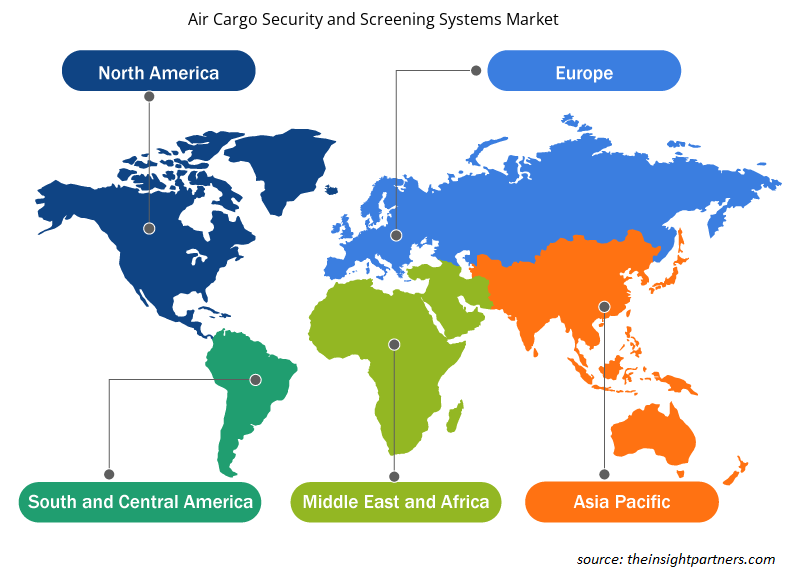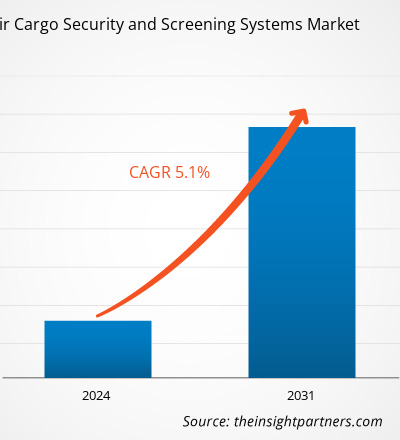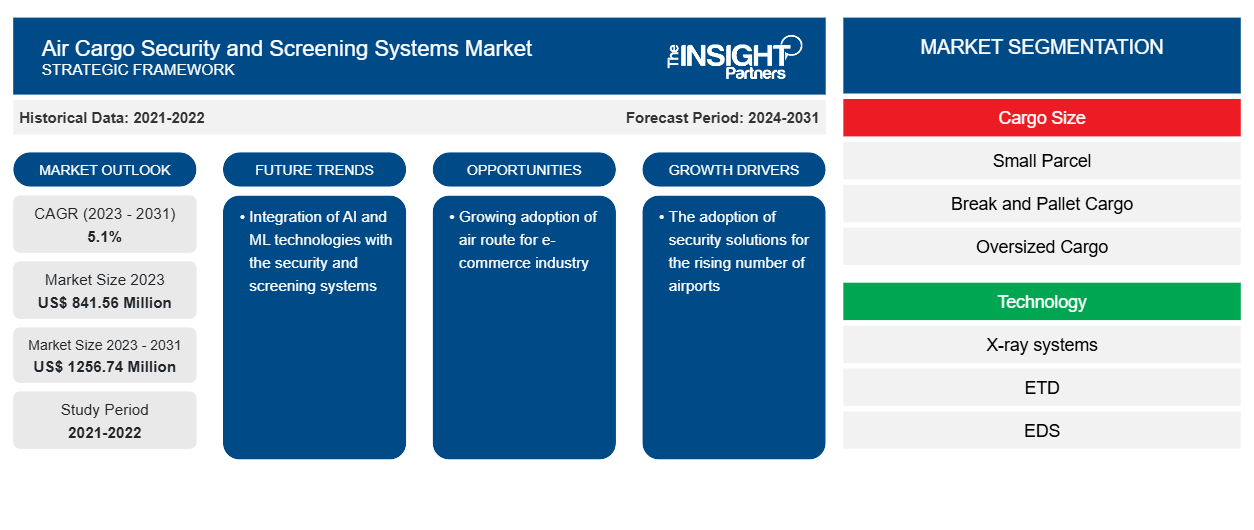Se prevé que el tamaño del mercado de sistemas de seguridad y control de carga aérea alcance los 1256,74 millones de dólares estadounidenses en 2031, frente a los 841,56 millones de dólares estadounidenses en 2023. Se espera que el mercado registre una CAGR del 5,1 % durante el período 2023-2031. Es probable que la adopción de soluciones de seguridad para el creciente número de aeropuertos y la creciente industria del comercio electrónico sigan siendo tendencias clave en el mercado.CAGR of 5.1% during 2023–2031. The adoption of security solutions for the rising number of airports and the growing e-commerce industry are likely to remain key trends in the market.
Análisis del mercado de sistemas de seguridad y control de carga aérea
El creciente sector del comercio electrónico está impulsando el crecimiento del mercado. El creciente número de aeropuertos genera la demanda de soluciones de seguridad aeroportuaria, lo que impulsa aún más el crecimiento del mercado. El aumento de los ataques terroristas y el tráfico de drogas en el mundo generan la demanda de sistemas de seguridad y control aeroportuarios. El enfoque de gestión de riesgos de los aeropuertos impulsa la necesidad de soluciones de seguridad.fuelling the market growth. The rising number of airports generates the demand for airport security solutions, which further drives market growth. The rising terrorist attacks and drug trafficking in the world generate the demand for airport security and screening systems. The risk management approach of the airports drives the need for security solutions.
Descripción general del mercado de sistemas de seguridad y control de carga aérea
Los sistemas de seguridad y control de carga aérea desempeñan un papel crucial para garantizar la seguridad de las personas en los aeropuertos. Estos sistemas proporcionan tecnología de detección a los operadores aeroportuarios con la que pueden detectar cualquier objeto explosivo, estupefacientes, metales y contrabando. Para evitar ataques terroristas y tráfico de drogas, estos sistemas son necesarios en los aeropuertos.
Personalice este informe según sus necesidades
Obtendrá personalización en cualquier informe, sin cargo, incluidas partes de este informe o análisis a nivel de país, paquete de datos de Excel, así como también grandes ofertas y descuentos para empresas emergentes y universidades.
-
Obtenga las principales tendencias clave del mercado de este informe.Esta muestra GRATUITA incluirá análisis de datos, desde tendencias del mercado hasta estimaciones y pronósticos.
Impulsores y oportunidades del mercado de sistemas de seguridad y control de carga aérea
Creciente adopción de rutas aéreas para la industria del comercio electrónico
La industria del comercio electrónico está experimentando un rápido crecimiento. Para entregar los productos más rápidamente a los clientes, la industria del transporte marítimo está cambiando hacia la ruta aérea. El factor de velocidad juega un papel crucial en los envíos minoristas a través de rutas aéreas. Las compañías aéreas a veces transportan carga en los vuelos de pasajeros y de carga. Este factor ha generado la demanda de sistemas de seguridad y control de carga aérea.
El creciente mercado de la electrónica de consumo
El enfoque del gobierno en garantizar la seguridad de la carga aérea impulsa la demanda de sistemas de seguridad y control de la carga aérea. Por ejemplo, la Administración de Seguridad del Transporte (TSA) del Departamento de Seguridad Nacional (DHS) y la Oficina de Aduanas y Protección Fronteriza (CBP) de los Estados Unidos abordan la seguridad de la carga aérea con destino a los Estados Unidos a través de programas distintos y han tomado medidas para medir su eficacia. La TSA lleva a cabo un programa de inspección para garantizar que las compañías aéreas cumplan con los requisitos de seguridad específicos relacionados con la carga, como los requisitos relacionados con el control y la custodia, la aceptación de la carga y los procedimientos de control.TSA) and US Customs and Border Protection (CBP) address US-bound air cargo security through distinct programs and they have taken steps to measure their effectiveness. TSA conducts an inspection program to ensure that air carriers are comply with specific cargo-related security requirements, such as requirements related to control and custody,
Análisis de segmentación del informe de mercado de sistemas de seguridad y control de carga aérea
Los segmentos clave que contribuyeron a la derivación del análisis del mercado de sistemas de seguridad y control de carga aérea son el tamaño de la carga, la tecnología y la aplicación.
- Según el tamaño de la carga, el mercado de sistemas de seguridad y control de carga aérea se divide en paquetes pequeños, carga fraccionada y en palés, y carga de gran tamaño. Se espera que el segmento de carga de gran tamaño crezca con la CAGR más alta.oversized cargo. The oversized cargo segment is expected to grow with the highest CAGR.
- Por tecnología, el mercado está segmentado en sistemas de rayos X, ETD (detección de trazas de explosivos), EDS (sistema de detección de explosivos) y otros. El segmento de sistemas de rayos X tuvo una participación significativa del mercado en 2023.
- Por aplicación, el mercado está segmentado en detección de narcóticos, detección de explosivos, detección de metales y contrabando, entre otros. El segmento de detección de metales y contrabando tuvo una participación significativa en el mercado en 2023.
Análisis de la cuota de mercado de los sistemas de seguridad y control de carga aérea por geografía
El alcance geográfico del informe de mercado de sistemas de seguridad y control de carga aérea se divide principalmente en cinco regiones: América del Norte, Asia Pacífico, Europa, Medio Oriente y África, y América del Sur y Central.
América del Norte posee una importante participación en el mercado mundial en 2023. Las crecientes preocupaciones por la seguridad en los aeropuertos impulsan el crecimiento del mercado en la región. La creciente industria del comercio electrónico en la región está generando demanda de soluciones de seguridad para la carga aérea. La inversión del gobierno en mejorar la seguridad aeroportuaria fomenta aún más el crecimiento del mercado en la región.
Perspectivas regionales del mercado de sistemas de seguridad y control de carga aérea
Los analistas de Insight Partners explicaron en detalle las tendencias y los factores regionales que influyen en el mercado de sistemas de seguridad y control de carga aérea durante el período de pronóstico. Esta sección también analiza los segmentos y la geografía del mercado de sistemas de seguridad y control de carga aérea en América del Norte, Europa, Asia Pacífico, Oriente Medio y África, y América del Sur y Central.

- Obtenga datos regionales específicos para el mercado de sistemas de seguridad y control de carga aérea
Alcance del informe de mercado de sistemas de seguridad y control de carga aérea
| Atributo del informe | Detalles |
|---|---|
| Tamaño del mercado en 2023 | US$ 841,56 millones |
| Tamaño del mercado en 2031 | US$ 1256,74 millones |
| CAGR global (2023 - 2031) | 5,1% |
| Datos históricos | 2021-2022 |
| Período de pronóstico | 2024-2031 |
| Segmentos cubiertos |
Por tamaño de carga
|
| Regiones y países cubiertos |
América del norte
|
| Líderes del mercado y perfiles de empresas clave |
|
Densidad de actores del mercado de sistemas de seguridad y control de carga aérea: comprensión de su impacto en la dinámica empresarial
El mercado de sistemas de seguridad y control de carga aérea está creciendo rápidamente, impulsado por la creciente demanda de los usuarios finales debido a factores como la evolución de las preferencias de los consumidores, los avances tecnológicos y una mayor conciencia de los beneficios del producto. A medida que aumenta la demanda, las empresas amplían sus ofertas, innovan para satisfacer las necesidades de los consumidores y aprovechan las tendencias emergentes, lo que impulsa aún más el crecimiento del mercado.
La densidad de actores del mercado se refiere a la distribución de las empresas o firmas que operan dentro de un mercado o industria en particular. Indica cuántos competidores (actores del mercado) están presentes en un espacio de mercado determinado en relación con su tamaño o valor total de mercado.
Las principales empresas que operan en el mercado de sistemas de seguridad y control de carga aérea son:
- Astrofísica Inc.
- Innovaciones de Dhonaadhi Hitec
- Sistemas de imagen Krystalvision Pvt Ltd
- Compañía Nuctech Limitada
- Sistemas Rapiscan, Inc.
- Safran SA
Descargo de responsabilidad : Las empresas enumeradas anteriormente no están clasificadas en ningún orden particular.

- Obtenga una descripción general de los principales actores clave del mercado de sistemas de seguridad y control de carga aérea
Noticias y desarrollos recientes del mercado de sistemas de seguridad y control de carga aérea
El mercado de sistemas de seguridad y control de carga aérea se evalúa mediante la recopilación de datos cualitativos y cuantitativos posteriores a la investigación primaria y secundaria, que incluye publicaciones corporativas importantes, datos de asociaciones y bases de datos. A continuación, se enumeran algunos de los avances en el mercado de sistemas de seguridad y control de carga aérea:
- En el marco del PLAN DE INVERSIÓN DE CAPITAL para los años fiscales 2024-2028, el país se centra en el Programa de Seguridad de Carga Aérea que colabora con la industria para desarrollar requisitos y calificar tecnologías para abordar las brechas de capacidad identificadas en la seguridad de inspección de carga aérea. (Fuente: Departamento de Seguridad Nacional de EE. UU., comunicado de prensa, agosto de 2023)
Informe sobre el mercado de sistemas de seguridad y control de carga aérea: cobertura y resultados
El informe "Tamaño y pronóstico del mercado de sistemas de seguridad y control de carga aérea (2021-2031)" proporciona un análisis detallado del mercado que cubre las siguientes áreas:
- Tamaño del mercado de sistemas de seguridad y control de carga aérea y pronóstico a nivel mundial, regional y nacional para todos los segmentos clave del mercado cubiertos bajo el alcance
- Tendencias del mercado de sistemas de seguridad y control de carga aérea, así como dinámica del mercado, como impulsores, restricciones y oportunidades clave
- Análisis detallado de las cinco fuerzas de Porter y PEST y FODA
- Análisis del mercado de sistemas de seguridad y control de carga aérea que abarca las tendencias clave del mercado, el marco global y regional, los principales actores, las regulaciones y los desarrollos recientes del mercado
- Análisis del panorama de la industria y de la competencia que abarca la concentración del mercado, el análisis de mapas de calor, los actores destacados y los desarrollos recientes para el mercado de sistemas de seguridad y control de carga aérea
- Perfiles detallados de empresas
- Análisis histórico (2 años), año base, pronóstico (7 años) con CAGR
- Análisis PEST y FODA
- Tamaño del mercado, valor/volumen: global, regional y nacional
- Industria y panorama competitivo
- Conjunto de datos de Excel
Informes recientes
Informes relacionados
Testimonios
Razón para comprar
- Toma de decisiones informada
- Comprensión de la dinámica del mercado
- Análisis competitivo
- Información sobre clientes
- Pronósticos del mercado
- Mitigación de riesgos
- Planificación estratégica
- Justificación de la inversión
- Identificación de mercados emergentes
- Mejora de las estrategias de marketing
- Impulso de la eficiencia operativa
- Alineación con las tendencias regulatorias























 Obtenga una muestra gratuita para - Mercado de sistemas de seguridad y control de carga aérea
Obtenga una muestra gratuita para - Mercado de sistemas de seguridad y control de carga aérea